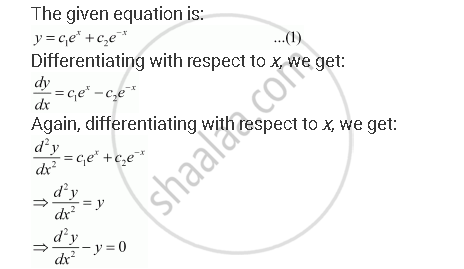Advertisements
Advertisements
Question
Which of the following differential equations has y = c1 ex + c2 e–x as the general solution?
(A) `(d^2y)/(dx^2) + y = 0`
(B) `(d^2y)/(dx^2) - y = 0`
(C) `(d^2y)/(dx^2) + 1 = 0`
(D) `(d^2y)/(dx^2) - 1 = 0`
Solution

This is the required differential equation of the given equation of curve.
Hence, the correct answer is B.
APPEARS IN
RELATED QUESTIONS
Form the differential equation of the family of parabolas having vertex at origin and axis along positive y-axis.
Form the differential equation of the family of ellipses having foci on y-axis and centre at origin.
Form the differential equation of the family of circles having centre on y-axis and radius 3 units.
Which of the following differential equation has y = x as one of its particular solution?
A. `(d^2y)/(dx^2) - x^2 (dy)/(dx) + xy = x`
B. `(d^2y)/(dx^2) + x dy/dx + xy = x`
C. `(d^2y)/(dx^2) - x^2 dy/dx + xy = 0`
D. `(d^2y)/(dx^2) + x dy/dx + xy = 0`
Form the differential equation corresponding to y = emx by eliminating m.
Form the differential equation corresponding to y2 − 2ay + x2 = a2 by eliminating a.
Represent the following families of curves by forming the corresponding differential equations (a, b being parameters):
x2 + y2 = a2
Represent the following families of curves by forming the corresponding differential equations (a, b being parameters):
x2 − y2 = a2
Represent the following families of curves by forming the corresponding differential equations (a, b being parameters):
(x − a)2 − y2 = 1
Represent the following families of curves by forming the corresponding differential equations (a, b being parameters):
Represent the following families of curves by forming the corresponding differential equations (a, b being parameters):
x2 + y2 = ax3
Represent the following families of curves by forming the corresponding differential equations (a, b being parameters):
y = eax
Show that y = bex + ce2x is a solution of the differential equation, \[\frac{d^2 y}{d x^2} - 3\frac{dy}{dx} + 2y = 0\]
Find one-parameter families of solution curves of the following differential equation:-
\[\frac{dy}{dx} - y = \cos 2x\]
Find one-parameter families of solution curves of the following differential equation:-
\[x\frac{dy}{dx} + y = x^4\]
Find one-parameter families of solution curves of the following differential equation:-
\[\left( x \log x \right)\frac{dy}{dx} + y = \log x\]
Find one-parameter families of solution curves of the following differential equation:-
\[\frac{dy}{dx} - \frac{2xy}{1 + x^2} = x^2 + 2\]
Find one-parameter families of solution curves of the following differential equation:-
\[\left( x + y \right)\frac{dy}{dx} = 1\]
Find one-parameter families of solution curves of the following differential equation:-
\[x \log x\frac{dy}{dx} + y = 2 \log x\]
Write the differential equation representing family of curves y = mx, where m is arbitrary constant.
The differential equation which represents the family of curves y = eCx is
The family of curves in which the sub tangent at any point of a curve is double the abscissae, is given by
Form the differential equation representing the family of curves `y2 = m(a2 - x2) by eliminating the arbitrary constants 'm' and 'a'.
Find the area of the region bounded by the curves (x -1)2 + y2 = 1 and x2 + y2 = 1, using integration.
Form the differential equation representing the family of curves y = e2x (a + bx), where 'a' and 'b' are arbitrary constants.
Find the equation of a curve passing through origin and satisfying the differential equation `(1 + x^2) "dy"/"dx" + 2xy` = 4x2
Form the differential equation by eliminating A and B in Ax2 + By2 = 1
The differential equation `y ("d"y)/("d"x) + "c"` represents: ______.
The differential equation of the family of curves x2 + y2 – 2ay = 0, where a is arbitrary constant, is ______.
Differential equation representing the family of curves y = ex (Acosx + Bsinx) is `("d"^2y)/("d"x^2) - 2 ("d"y)/("d"x) + 2y` = 0
Find the equation of the curve at every point of which the tangent line has a slope of 2x:
The area above the x-axis and under the curve `y = sqrt(1/x - 1)` for `1/2 ≤ x ≤ 1` is:
From the differential equation of the family of circles touching the y-axis at origin
Form the differential equation of family of circles having centre on y-axis and raduis 3 units
Form the differential equation of the family of hyperbola having foci on x-axis and centre at origin.
